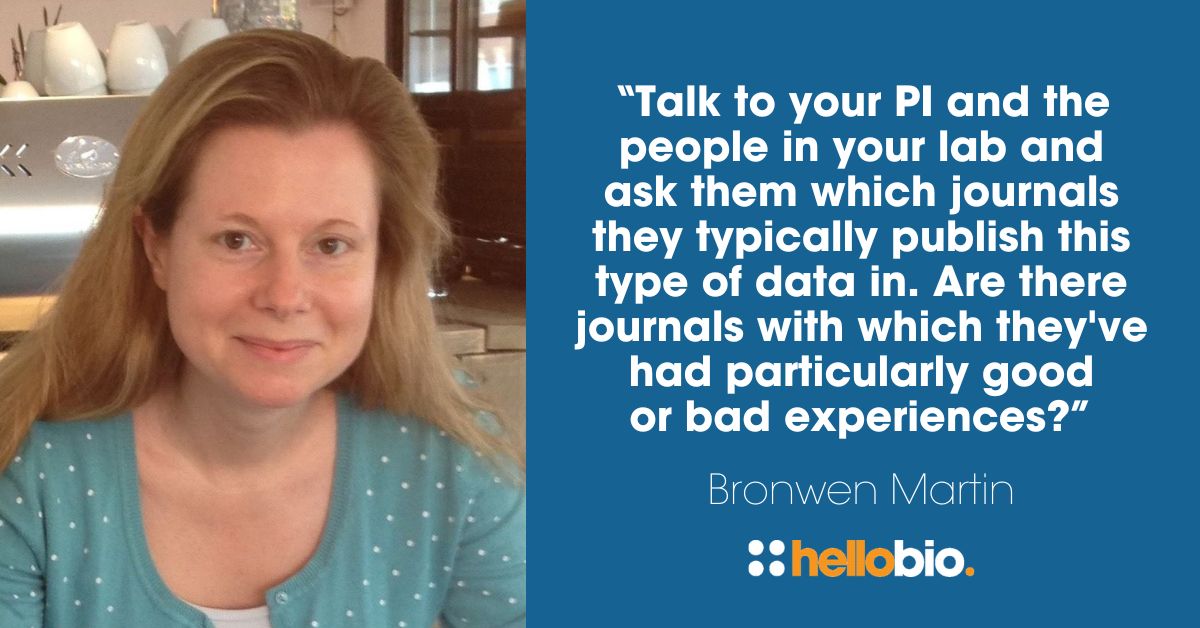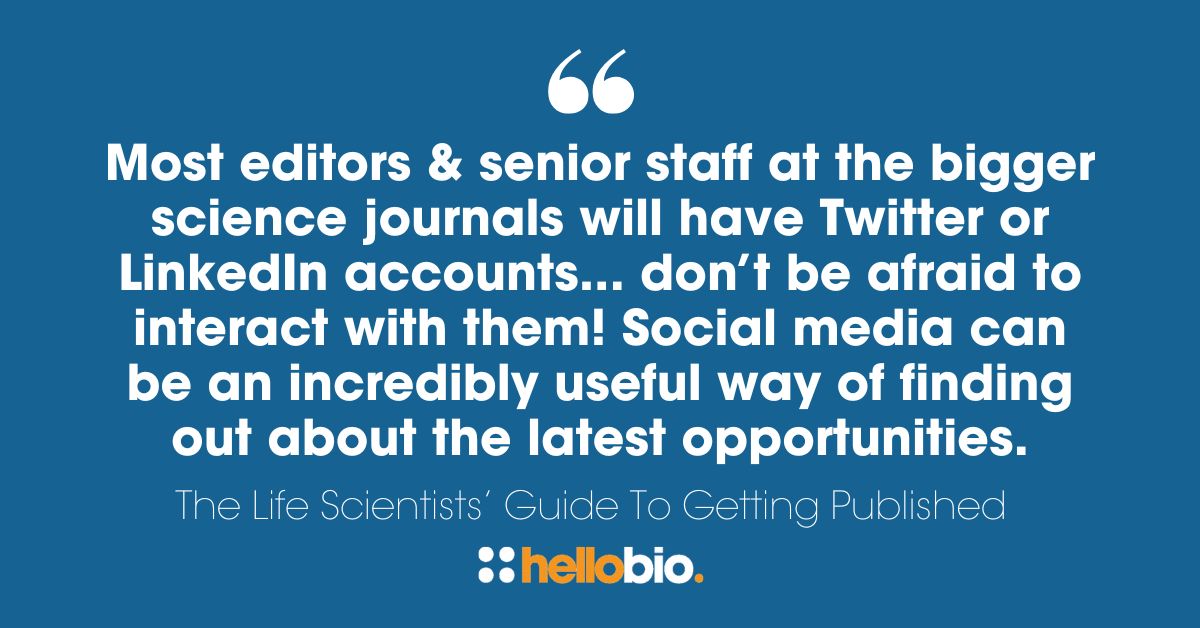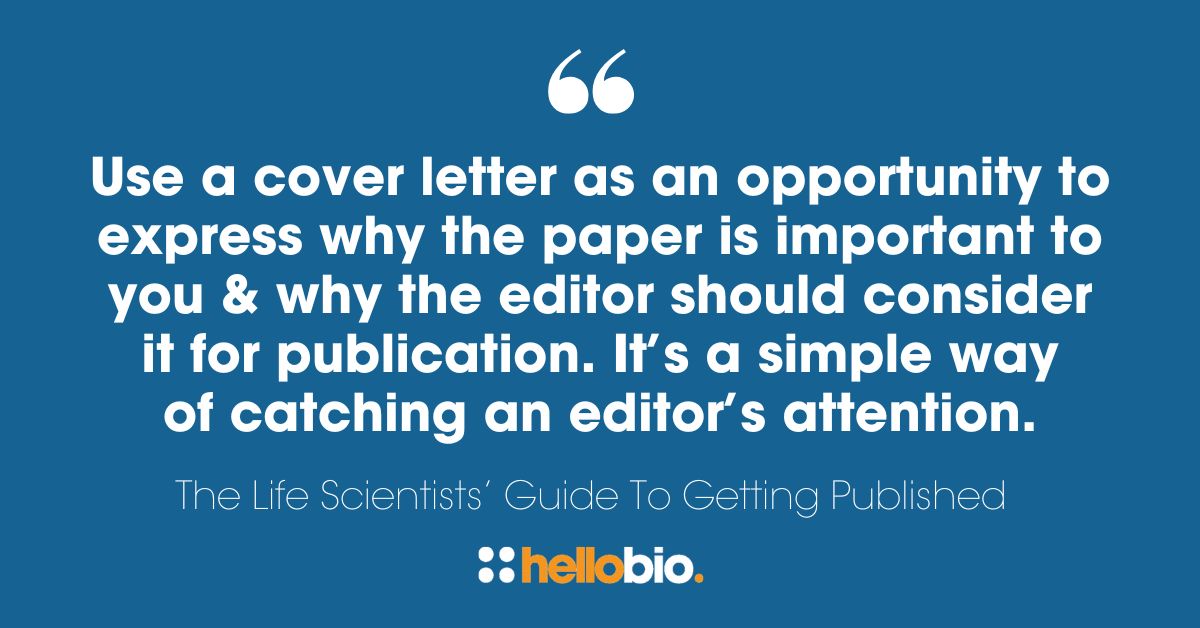The Life Scientists’ Guide to Getting Published
So you’ve spent months working on a great scientific paper, compiling all of your results and findings into a compelling piece of writing. You’re excited for people to read your work… but how do you go about getting it published?
As life science researchers we’re told that having our work published in influential journals is key to academic success, but while getting published may be important for our careers, it’s also incredibly difficult. With stiff competition and high rejection rates from most major journals, getting your work to print can be a daunting task. Your manuscript will need to be impactful, relevant and novel. It will need to tell a great story and be accurate and thoroughly researched in order to survive the peer review process.
And there’s so much more to consider before you even hit “submit”. That’s why we’ve gathered some great tips from experienced scientists who have shared their valuable advice and insight to help you get your paper published.
1. Choose the right journal for your paper
Not every journal will be right for your paper, so it’s important from the outset to think hard about which journals you might like to approach. Many will have specialisms, or will be looking for particular themes or topics at different times. Take some time to research the relevant journals for your field of study and find out what they are looking for currently. Putting in this work now will give you a better chance of success and will also ensure you reach a more targeted and relevant audience when your work does get published.
A great way to source some of this information is to talk to colleagues or peers working in the same field and find out which journals they have submitted to previously, and which ones they had most (or least) success with.
Dr Bronwen Martin, a Scientific Editor & Research Communicator in the Faculty of Pharmaceutical, Biomedical and Veterinary Sciences at the University of Antwerp, Belgium, shared her thoughts on this approach. She told us: “Talk to your PI and the people in your lab and ask them which journals they typically publish this type of data in. Are there journals with which they've had particularly good or bad experiences? Get feedback and advice from the people working around you because they might be able to offer you some valuable information.”
There are also a number of online databases you can use to search for relevant journals. They will have information on each publication stored and searchable by keyword, making it easier to pinpoint the journals that regularly publish on similar topics and themes as your paper. Here are a few to consider:
Be sure you have matching aims
When selecting a journal to submit your paper to, be sure to read their aims, scope, and requirements carefully. You’ll want to be 100% sure that your work is a good match and that the purpose of your research is aligned with that of the journal.
Also, make sure you are presenting your manuscript to them in the correct format. Ideally this will be something you will have considered at the writing stage so won’t need too much adjustment, but be aware that some journals will specifically require additional details such as tables, figures or references. Check their author guidelines to ensure you’re meeting their requirements and to avoid your paper being instantly rejected on receipt.
For further advice on writing, structure and formatting scientific papers, take a look at our useful writing resource pack: The Art of Writing Scientific Papers: Resources for Researchers
Write a pre-submission enquiry
Another great way to check the suitability of a proposed paper is to send a pre-submission enquiry to the editor. It can save a lot of time and effort further down the line if the journal can tell you from the outset whether your paper is going to be suitable for them or not. A pre-submission enquiry should include a 250-500 word synopsis of your proposed paper and details of any additional authors.
Dr James Quinn, a neurology research fellow in the Alzheimer’s Clinical & Translational Research Unit (ACTRU) at Massachusetts General Hospital and Harvard Medical School, recommends this approach. He told us: “I've submitted many pre-submission enquiries to high impact factor journals. I’ve always found the process of pulling together a short 500-word summary of the article to be an extremely helpful part of the writing process, and I find that it's definitely helpful to have a journal in mind before you start writing.”
REMEMBER! Only submit to one journal at a time
When it comes to choosing journals to submit to, by all means make a list of potential publications but be sure you only submit to one at a time! For most journals this is a strict policy because it prevents any potential confusion or copyright issues should communication breakdowns occur later down the line. Only once you’ve received a definite and final rejection from one journal should you submit your work to your next preferred journal.
2. Network for contacts and recommendations
If you’re already working in science you’ll know the importance of networking and making connections with other professionals in your field. Connecting with other science writers, editors and publishing professionals is equally as important if you want to see your work in print.
Try to attend events or workshops where editors might be speaking or sharing information. Approach other science writers at conferences and pick their brains. The sooner you start to build a strong network of relevant contacts the better.
Bronwen told us how at her previous workplace they would have regular visits from editors: “I used to work at the National Institutes of Health in Maryland, USA, and we would often have visitations or lectures from editors of journals. People on the editorial team would come to our campus to talk about their journal, share their review processes, and discuss the type of work that their particular journal was interested in. Go to these presentations, meet these editors and start creating a network of people who might be able to help you when the time comes to submit a paper for publication.”
Create a strong online presence for yourself
Having a good online presence for yourself and your research is also something to think about. If you don’t already have one, consider creating your own simple website introducing yourself and outlining your research and areas of interest. Be sure also to update your profiles on professional sites such as ResearchGate and LinkedIn. Editors are likely to take a look online to check your credibility when considering your work for publication. Building up a good online presence can help to ensure you are taken seriously.
For more advice on putting yourself out there as a researcher, take a look at The Life Scientists’ Guide To Promoting Yourself and Your Work.
REMEMBER! Make good use of social media
Don’t disregard social media - it’s a powerful tool and a great way of making professional contacts and connections. Most editors and senior staff at the bigger science journals will have Twitter or LinkedIn accounts and will be active in other online spaces. Be sure to follow those that you are interested in and don’t be afraid to interact with them! Social media can be an incredibly useful way of finding out about the latest publishing opportunities.
3. Ensure your manuscript is in shape for submission
By this point you will have finished writing your paper and will be happy with its content. However, there is always more you can do to ensure it’s in the best possible shape for submission to a journal.
Read, read and read again!
Read and re-read your paper several times and go over the fine details as carefully as you can. You’re far more likely to spot any mistakes this way. Remember that clarity is vital in scientific writing, so if anything doesn’t seem 100% clear when you revisit it, be sure to put this right before sending it out to a journal.
Share your manuscript with colleagues and ask for their feedback, especially any that are regular peer reviewers. They may be able to spot errors or suggest slight changes that could give your paper that extra edge.
Fine-tune your title and abstract
Wording is essential, so give yourself the best chance of being accepted by using the right words in your title and abstract. The title needs to clearly summarise the theme of the paper, while the abstract should detail the aim and scope of the research, and include your methods, data set, the problems addressed and the key findings.
Bronwen Martin explains the importance of using the right wording: “Think carefully about your title and your abstract. Once published, search engines will be used to access your paper, so anyone searching on PubMed or Google will look for specific keywords. If those words aren't included in your title or your abstract then your paper won't be found. Remember that there are approximately 35 million publications on PubMed at the moment, so it's important that you give your paper the best chance of being found and being read by the right people.”
REMEMBER! Add a cover letter
Something that’s often overlooked is the inclusion of a cover letter when submitting a paper. You can use a cover letter as an opportunity to briefly express why the paper is important to you and why the editor should consider it for publication. State the main theme of the paper, its relevance to the journal, and explain why your research is novel and will be of interest to others. It’s a simple way of catching an editor’s attention and raising your paper to the top of the consideration pile. Highlighting the novelty and context of your paper is also helpful for reviewers.
4. Ask questions about rejections
If your paper is rejected, this doesn’t instantly mean ‘game over’ for you and that particular journal. Don’t be afraid to follow up with questions about why your paper was rejected, what you could have done differently, and what they were looking for which maybe wasn’t included. Editors will often be happy to provide feedback, and constructive dialogue with an editor can often lead to a paper being reconsidered.
Dr Matthew Lloyd is a Senior Lecturer (Associate Professor) at the University of Bath and he told us about a couple of examples of rejection which after negotiation eventually led to publication: “Generally speaking if I get a paper rejected, or even if it comes back with major revisions then I will always contact the editor and ask for further clarification. It depends on the circumstances, but for example, about 10 years ago I had a paper rejected because the reviewer clearly hadn't read the paper properly. They had suggested doing a number of experiments which we'd already done, so I wrote back to the editor and explained the situation. The editor allowed us to resubmit the paper, but the second reviewer also raised concerns which we disagreed with. At this point we came to the conclusion that perhaps we were sending the paper to the wrong journal, so we used the editor’s feedback and submitted and published with a different journal instead. I also had a review article recently which was well-received by the reviewers but the editor had expressed some concerns. I had an extended conversation with the editor which was very helpful and we eventually ended up rewriting the paper and it was published nearly a year after the original submission. So conversations with the editor were extremely helpful in both cases.”
Bronwen added: “We've all had papers rejected. I think it's quite a normal process, but often it depends for what reason it was rejected. Sometimes if you contact the editor, you may find that with the necessary changes they might still be interested, so it's worth contacting them and proposing your own modifications. If the editor says yes, then it's definitely worth going on a process with that journal. Don’t be afraid to start that conversation, but if they make it very clear that it's not within their scope, then just cut your losses and try another journal.”
Nobody likes criticism, but do consider any comments or feedback very carefully and use it to your advantage. Learn from their expert advice because their words are intended to help you, not knock you back.
For more useful tips on handling rejection as a scientist, take a look at The Life Scientists’ Guide to Coping with Rejection and Getting Accustomed to Rejection by guest blogger Danielle L Tomasello.
Revise where necessary
If revisions are recommended, then be sure to address them thoroughly. When you resubmit a paper you will be expected to provide written acknowledgment of the changes you have made and your responses to any concerns raised by the reviewers. Highlighting the changes in the resubmitted manuscript will help the editor and/or reviewers evaluate whether their concerns have been addressed.
REMEMBER! Meet the revision deadline
If you are resubmitting after revisions, be sure to do so by the deadline you’ve been given. If you know you’re not going to be able to meet that deadline, be sure to contact the journal and request an extension as soon as possible.
5. Consider alternatives to full publication
If you’re facing rejection, remember that there are other ways of getting your papers read that don’t require publication in journals. You can upload your manuscripts directly to sites such as ResearchGate or ORCID where they can be found through keyword searches, or you can include links to your work on your social media or email accounts.
James Quinn said: “The first thing I tell my students to do is get a Google Scholar account, get a ResearchGate account, get ORCID, register and share your work everywhere because the number of people that have read my publications just on ResearchGate for example, is huge. Consider sharing on Twitter and LinkedIn as well because people will click on your paper from those accounts too. I've even seen people put publications on their email signature because it’s another helpful way of getting your work in front of people who might be interested.”
To preprint or not to preprint?
Another option to consider is the use of preprint servers. The popularity of this method rocketed during the COVID-19 pandemic, with scientists using preprints more regularly to publish work before peer review or full publication. It’s a great way to make your research public quickly, although readers will always need to keep in mind that these are early versions of manuscripts which have not been reviewed formally. There are pros and cons to preprint servers, but their use is certainly still increasing in popularity at the moment.
Bronwen shared her thoughts on the subject: “I think preprint servers are very exciting. We saw a huge influx of thousands of papers being added to preprint servers during the pandemic and that was very much the turning point in my opinion for these servers to become more mainstream. It’s now much more common for researchers to put their papers on a preprint server, for example bioRxiv in the biomedical sciences, and there are actually more and more journals now that require a preprint first before you can submit a manuscript to them. I'm all for them. I think that they're a great step towards the future and they will help to have more of an open peer review process which I also think is a significant step forward. I would say if you can there's nothing wrong with depositing your papers in a preprint server. I think it's an excellent way forward.”
While some journals encourage the use of preprint, others prefer exclusivity for their publications and will request that your paper has not been published anywhere else beforehand.
Matthew reiterates this: “I think generally speaking preprints are very good, but the one note of caution I would add is if you have a journal in mind that you're hoping to eventually publish with, be sure to check their author guidelines to see what they say about pre-publication because not all journals encourage it.”
It can however be a great way to get your name out there, as James Quinn told us: “We know that preprint is not the same as a full publication but it's very much putting you on the right page. A lot of funders like to see examples of preprint because it does tick that box of having a publication of sorts. Maybe it's not a full publication but it's showing that you're able to pull your work together in a format that can be accessible and can be reviewed by others in the field.”
And finally… don’t give up!
Getting published is tough and it’s incredibly rare for early career researchers to have a paper accepted on their first attempt. High-impact factor journals select only a very small percentage of the papers submitted to them, so if you do receive multiple rejections, don’t take it to heart. Remember that rejection is a huge part of science and you should never see this as failure, rather a great opportunity to learn and develop as a writer.
James Quinn agrees: “Rejection is extremely normal in academia, and you do become slightly immune to it as time goes on because it's such a normal part of what we do. It's extremely competitive but there are thousands of journals out there so don't be afraid to aim high, and if you get in, great! If you don't, just set your goals a little bit lower and then really focus on just getting your story out there somehow, even if it does mean having to negotiate a little bit with the editor or resubmitting elsewhere.”
So don’t give up, keep writing, and be sure to enjoy the moment when you finally get that paper published!
----------------------------------
Watch the full panel discussion at the Hello Bio LabLife Conference
This guide is based on the panel discussion ‘Writing, Peer-Reviewing & Publishing Papers’ at the Hello Bio virtual LabLife Conference in June 2022. You can watch the full video on the Hello Bio YouTube channel here:
Writing, Peer-Reviewing & Publishing Papers | The Hello Bio LabLife Conference 2022
__________________________________________________
If you enjoyed this article, why not check out the other resources available on our blog. We are passionate about supporting life scientists including early career life scientists and PhD students - with really low-priced reagents, antibodies and biochemicals, early career scientist grants, and resources to help with both personal and professional development. We know how tough it is - so we hope you find these helpful!
More General Support for Life Scientists
For advice on wellbeing, dissertations, presenting at conferences, wellbeing, PhD support, networking and lots more, we have a huge range of articles to help - just click below:
Save up to 50% on our high purity reagents...
When you get to the stage of planning your experiments, don't forget that we offer a range of low-cost, high-purity agonists, antagonists, inhibitors, activators, antibodies and fluorescent tools (yes - they really are around half the price of other suppliers!) You can use our Quick Multi-Search Tool to search for lots of products in one go, and the range includes:
- Enzyme inhibitors and activators
- Chemogenetic ligands
- Ion channel modulators
- GPCR & ionotropic receptor ligands
- Cell biology reagents & biochemicals
Technical resources
Try our Molarity Calculator: a quick and easy way to calculate the mass, volume or concentration required for making a solution.
Try our Dilution Calculator: an easy way to work out how to dilute stock solutions of known concentrations
We also offer a comprehensive range of technical resources including antibody protocols and methods, product guides and mini-reviews:
And finally, don't forget to check back in with our blog regularly for our latest articles. If there’s something you’d love to contribute to the community, whether that’s an interview or article, drop us a line at hello@hellobio.com
---
























